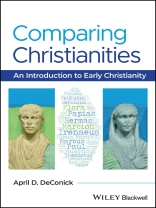A ground-breaking introductory textbook for the study of the New Testament and the first Christians, written for the next generation of students
Comparing Christianities: An Introduction to the New Testament and the First Christians maps the historical rise of Christianity out of a network of early Christian movements. This major new textbook systematically explores the struggles to define the faith by presenting Christianity as the result of a lengthy process of religious consolidation which emerged from a landscape of persistent Christian diversity.
The book delves into the history of the first five generations of Christians, from Paul to Origen. The first chapter considers the challenges of constructing Christian histories and offers a new model of Christian families to organize and explain the emergence and competition of different varieties of Christianity. Each successive chapter focuses on key issues that Christian leaders engaged over the centuries, demonstrating how the questions they posed and the answers they provided gave Christianity its distinct shape. As the movements competed for social advantage, Christians began identifying certain Christian movements as enemies and consolidated against them. The final chapter schematizes the Christians studied in the book into three families of Christian movements based on the particular God they worshipped and other shared patterns of thought and practice. This chapter also explains where the varieties of Christianities came from and how the process of consolidation undertaken by some churches shaped Christian identity within a forge of intolerance that still affects us today.
Comparing Christianities explores the answers to questions:
* Who were the early Christians and what did they write?
* What did Christians think about sex, women, immortality, Judaism, suffering and death?
* What rituals did the first Christians practice, and what did their religious experiences mean to them?
* How did Christians live in a Roman-dominated world?
* How did the first Christians explain the origins of their movement?
Comparing Christianities: An Introduction to the New Testament and the First Christians serves as an excellent primary textbook in undergraduate classrooms for Introduction to Christianity, Introduction to Religion, New Testament Studies, Christian Origins, World Religions, and Western World Religions, and a thought-provoking resource for anyone wishing to know more about Christianity.
Table of Content
Preface ix
Acknowledgments xi
1 Sectarian Jews 1
2 A New Religion 27
3 Early Gnostic Churches 49
4 The Church of the Martyrs 81
5 Early Christian Philosophical Movements 103
6 The Universal Church 131
7 Holiness Movements in Asia and Syria 157
8 The Expansion of Gnostic Churches 183
9 The Construction of Orthodoxy 207
10 Church Reform 231
11 The Mystical Church 257
12 A Family History 283
Glossary of Terms 327
Index 339
About the author
APRIL D. DECONICK is the Isla Carroll and Percy E. Turner Professor of New Testament and Early Christianity and the Director of the GEM (Gnosticism, Esotericism, and Mysticism) University Certificate Program at Rice University. She is the award-winning author of several books including The Gnostic New Age: How A Countercultural Spirituality Revolutionized Religion from Antiquity to Today. Professor De Conick was featured in the CNN special series Finding Judas in 2015.












